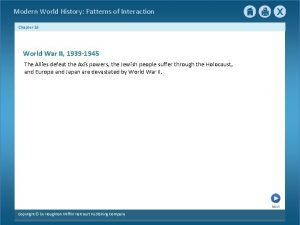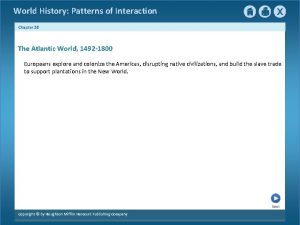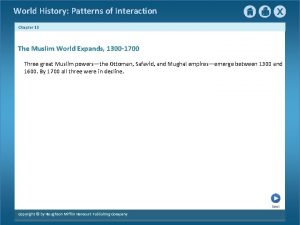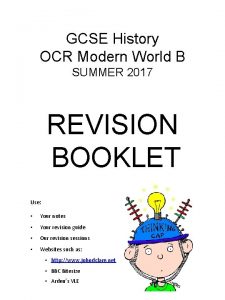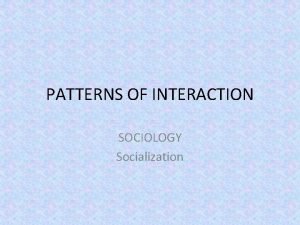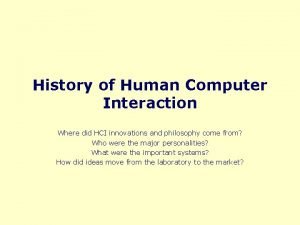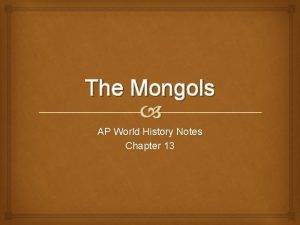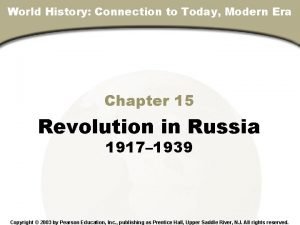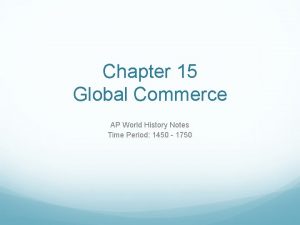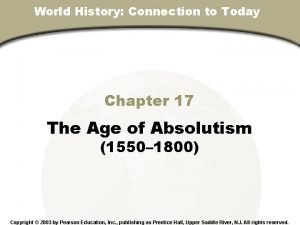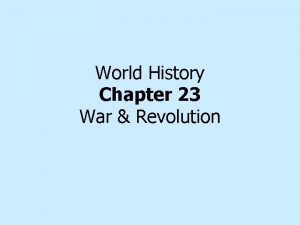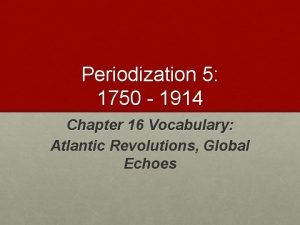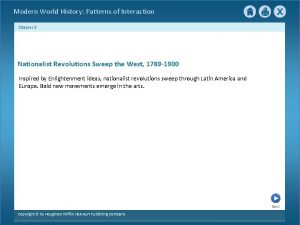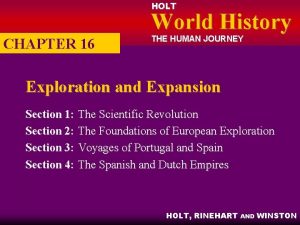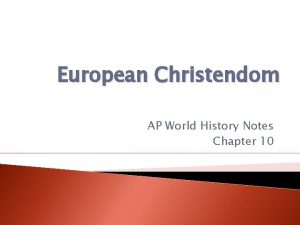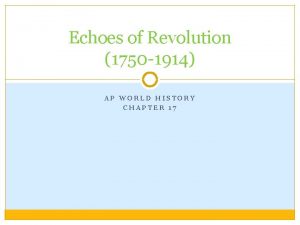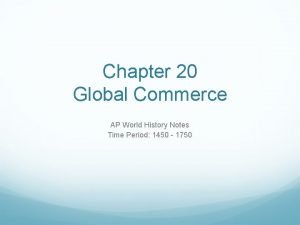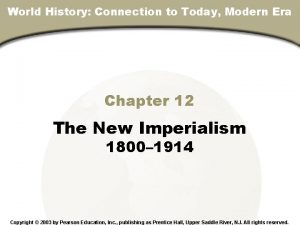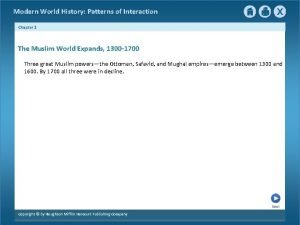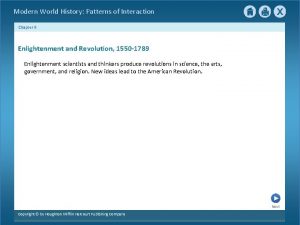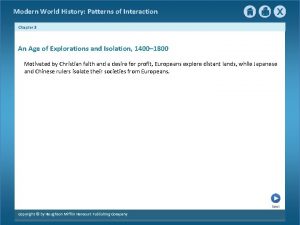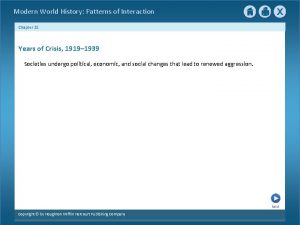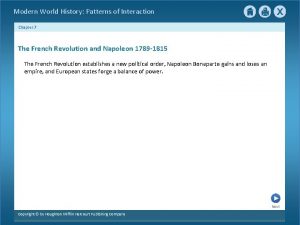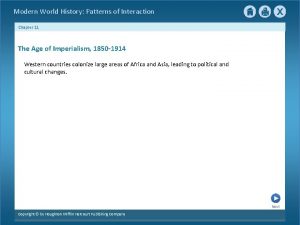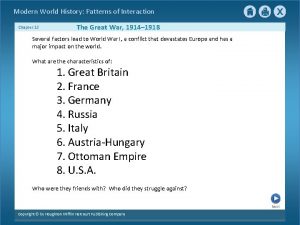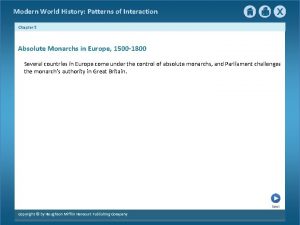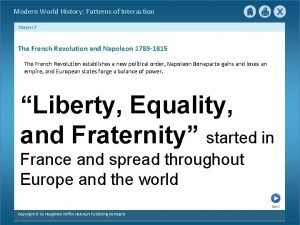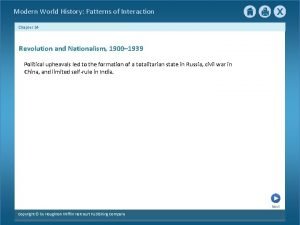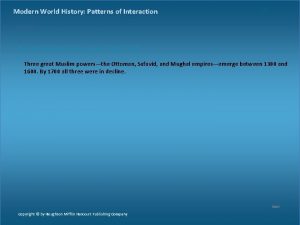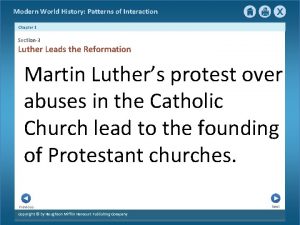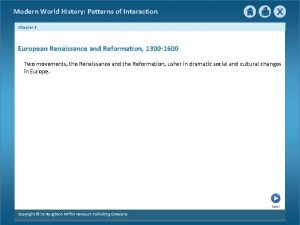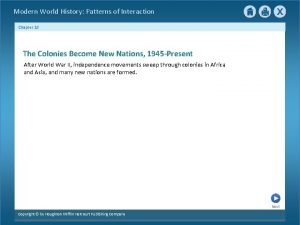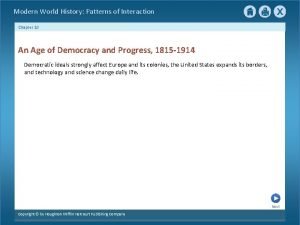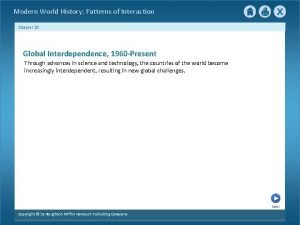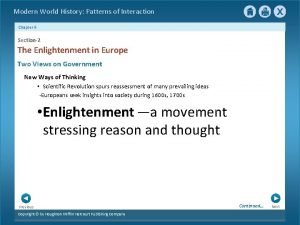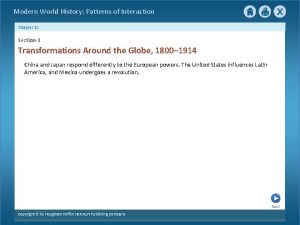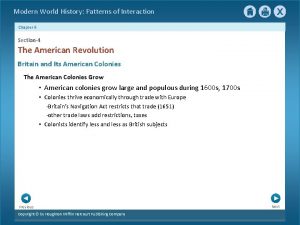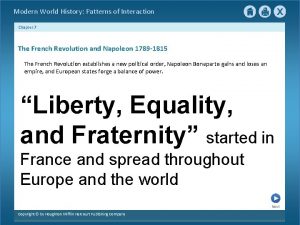Modern World History Patterns of Interaction Chapter 9

































- Slides: 33

Modern World History: Patterns of Interaction Chapter 9 The Industrial Revolution, 1700 -1900 The Industrial Revolution begins in Britain, spreads to other countries, and has a strong impact on economics, politics, and society. Next Copyright © by Houghton Mifflin Harcourt Publishing Company

Modern World History: Patterns of Interaction Chapter 9 The Industrial Revolution, 1700 -1900 SECTION 1 The Beginnings of Industrialization SECTION 2 CASE STUDY: Industrialization SECTION 3 Industrialization Spreads SECTION 4 Reforming the Industrial World Previous Copyright © by Houghton Mifflin Harcourt Publishing Company Next

Modern World History: Patterns of Interaction Chapter 9 Section-1 The Beginnings of Industrialization The Industrial Revolution starts in England soon spreads to other countries. Previous Copyright © by Houghton Mifflin Harcourt Publishing Company Next

Modern World History: Patterns of Interaction Chapter 9 Section-1 The Beginnings of Industrialization Industrial Revolution Begins in Britain New Ways of Working • Industrial Revolution—greatly increases output of machine-made goods • Revolution begins in England in the middle 1700 s The Agricultural Revolution Paves the Way • Enclosures—large farm fields enclosed by fences or hedges • Wealthy landowners buy, enclose land once owned by village farmers • Enclosures allow experimentation with new agricultural methods Previous Copyright © by Houghton Mifflin Harcourt Publishing Company Continued… Next

Modern World History: Patterns of Interaction Chapter 9 Industrialization Begins in Britain {continued} Rotating Crops • Crop rotation—switching crops each year to avoid depleting the soil • Livestock breeders allow only the best to breed, improve food supply Why the Industrial Revolution Began in England • Industrialization—move to machine production of goods • Britain has natural resources—coal, iron, rivers, harbors • Expanding economy in Britain encourages investment • Britain has all needed factors of production—land, labor, capital Previous Copyright © by Houghton Mifflin Harcourt Publishing Company Next

Modern World History: Patterns of Interaction Chapter 9 Inventions Spur Industrialization Changes in the Textile Industry • Weavers work faster with flying shuttles and spinning jennies • Water frame uses water power to drive spinning wheels • Power loom, spinning mule speed up production, improve quality • Factories—buildings that contain machinery for manufacturing • Cotton gin boosts American cotton production to meet British demand Previous Copyright © by Houghton Mifflin Harcourt Publishing Company Next

Modern World History: Patterns of Interaction Chapter 9 Improvements in Transportation Watt’s Steam Engine • Need for cheap, convenient power spurs development of steam engine • James Watt improves steam engine, financed by Matthew Boulton • Boulton an entrepreneur—organizes, manages, takes business risks Water Transportation • Robert Fulton builds first steamboat, the Clermont, in 1807 • England’s water transport improved by system of canals Road Transportation • British roads are improved; companies operate them as toll roads Previous Copyright © by Houghton Mifflin Harcourt Publishing Company Next

Modern World History: Patterns of Interaction Chapter 9 The Railway Age Begins Steam-Driven Locomotives • In 1804, Richard Trevithick builds first steam-driven locomotive • In 1825, George Stephenson builds world’s first railroad line The Liverpool-Manchester Railroad • Entrepreneurs build railroad from Liverpool to Manchester • Stephenson’s Rocket acknowledged as best locomotive (1829) Railroads Revolutionize Life in Britain • Railroads spur industrial growth, create jobs • Cheaper transportation boosts many industries; people move to cities Previous Copyright © by Houghton Mifflin Harcourt Publishing Company Next

Modern World History: Patterns of Interaction Chapter 9 Section-2 Industrialization CASE STUDY: Manchester The factory system changes the way people live and work, introducing a variety of problems. Previous Copyright © by Houghton Mifflin Harcourt Publishing Company Next

Modern World History: Patterns of Interaction Chapter 9 Section-2 Industrialization CASE STUDY: Manchester Industrialization Changes Life Factory Work • Factories pay more than farms, spur demand for more expensive goods Industrial Cities Rise • Urbanization—city-building and movement of people to cities • Growing population provides work force, market for factory goods • British industrial cities: London, Birmingham, • Manchester, Liverpool Previous Copyright © by Houghton Mifflin Harcourt Publishing Company Continued… Next

Modern World History: Patterns of Interaction Chapter 9 Industrialization Changes Life {continued} Living Conditions • Sickness widespread; epidemics, like cholera, sweep urban slums • Life span in one large city is only 17 years • Wealthy merchants, factory owners live in luxurious suburban homes • Rapidly growing cities lack sanitary codes, building codes • Cities also without adequate housing, education, police protection Previous Copyright © by Houghton Mifflin Harcourt Publishing Company Continued… Next

Modern World History: Patterns of Interaction Chapter 9 Industrialization Changes Life {continued} Working Conditions • Average working day 14 hours for 6 days a week, year round • Dirty, poorly lit factories injure workers • Many coal miners killed by coal dust Previous Copyright © by Houghton Mifflin Harcourt Publishing Company Next

Modern World History: Patterns of Interaction Chapter 9 Class Tensions Grow The Middle Class • Middle class—skilled workers, merchants, rich farmers, professionals • Emerging middle class looked down on by landowners , aristocrats • Middle class has comfortable standard of living The Working Class • Laborers’ lives not improved; some laborers replaced by machines • Luddites, other groups destroy machinery that puts them out of work • Unemployment a serious problem; unemployed workers riot Previous Copyright © by Houghton Mifflin Harcourt Publishing Company Next

Modern World History: Patterns of Interaction Chapter 9 Positive Effects of the Industrial Revolution Immediate Benefits • Creates jobs, enriches nation, encourages technological progress • Education expands, clothing cheaper, diet and housing improve • Workers eventually win shorter hours , better wages and conditions Long-Term Effects • Improved living and working conditions still evident today • Governments use increased tax revenues for urban improvements Previous Copyright © by Houghton Mifflin Harcourt Publishing Company Next

Modern World History: Patterns of Interaction Chapter 9 The Mills of Manchester Immediate Benefits • Creates jobs, enriches nation, encourages technological progress • Education expands, clothing cheaper, diet and housing improve • Workers eventually win shorter hours , better wages and conditions Manchester and the Industrial Revolution • Manchester has labor, water power, nearby port at Liverpool • Poor live and work in unhealthy, even dangerous, environment • Business owners make profits by risking their own money on factories • Eventually , working class sees its standard of living rise some Previous Copyright © by Houghton Mifflin Harcourt Publishing Company Continued… Next

Modern World History: Patterns of Interaction Chapter 9 The Mills of Manchester {continued} Children in Manchester Factories • Children as young as 6 work in factories; many are injured • 1819 Factory Act restricts working age, hours • Factory pollution fouls air, poisons river • Nonetheless , Manchester produces consumer goods and creates wealth Previous Copyright © by Houghton Mifflin Harcourt Publishing Company Next

Modern World History: Patterns of Interaction Chapter 9 Section-3 Industrialization Spreads The industrialization that begins in Great Britain spreads to other parts of the world. Previous Copyright © by Houghton Mifflin Harcourt Publishing Company Next

Modern World History: Patterns of Interaction Chapter 9 Section-3 Industrialization Spreads Industrial Development in the United States Industrialization in the United States • U. S. has natural and labor resources needed to industrialize • Samuel Slater, English textile worker, builds textile mill in U. S. • Lowell, Massachusetts a mechanized textile center by 1820 • Manufacturing towns spring up around factories across the country • Young single women flock to factory towns, work in textile mills • Clothing, shoemaking industries soon mechanize Previous Copyright © by Houghton Mifflin Harcourt Publishing Company Continued… Next

Modern World History: Patterns of Interaction Chapter 9 Industrial Development in the United States {continued} Later Expansion of U. S. Industry • Industrialization picks up during post-Civil War technology boom • Cities like Chicago expand rapidly due to location on railroad lines • Small companies merge to form larger, powerful companies The Rise of Corporations • Stock—limited ownership rights for company, sold to raise money • Corporation—company owned by stockholders, share profits not debts • Large corporations attempt to control as much business as they can Previous Copyright © by Houghton Mifflin Harcourt Publishing Company Next

Modern World History: Patterns of Interaction Chapter 9 Continental Europe Industrializes Troubles in Continental Europe • Revolution and Napoleonic wars disrupted early 19 th-century economy Beginnings in Belgium • Belgium has iron ore, coal, water transportation • British workers smuggle in machine plans, start companies (1799) Germany Industrializes • Political , economic barriers; but industry, railroads boom by mid-century Previous Copyright © by Houghton Mifflin Harcourt Publishing Company Continued… Next

Modern World History: Patterns of Interaction Chapter 9 Continental Europe Industrializes {continued} Expansion Elsewhere in Europe • Bohemia develops spinning; Northern Italy mechanizes silk textiles • Industrialization in France more measured; agriculture remains strong Previous Copyright © by Houghton Mifflin Harcourt Publishing Company Next

Modern World History: Patterns of Interaction Chapter 9 The Impact of Industrialization Rise of Global Inequality • Wealth gap widens; non-industrialized countries fall further behind • European nations, U. S. , Japan exploit colonies for resources • Imperialism spreads due to need for raw materials , markets Transformation of Society • Europe and U. S. gain economic power • African and Asian economies lag, based on agriculture , crafts • Rise of middle class strengthens democracy, calls for social reform Previous Copyright © by Houghton Mifflin Harcourt Publishing Company Next

Modern World History: Patterns of Interaction Chapter 9 Section-4 Reforming the Industrial World The Industrial Revolution leads to economic, social, and political reforms. Previous Copyright © by Houghton Mifflin Harcourt Publishing Company Next

Modern World History: Patterns of Interaction Chapter 9 Reforming the Industrial World The Philosophers of Industrialization Laissez-faire Economics • Laissez faire—economic policy of not interfering with businesses • Originates with Enlightenment economic philosophers • Adam Smith—defender of free markets, author of The Wealth of Nations • Believes economic liberty guarantees economic progress • Economic natural laws—self-interest, competition, supply and demand Previous Copyright © by Houghton Mifflin Harcourt Publishing Company Continued… Next

Modern World History: Patterns of Interaction Chapter 9 The Philosophers of Industrialization {continued} The Economists of Capitalism • Thomas Malthus, David Ricardo boost laissez-faire capitalism • Capitalism—system of privately owned businesses seeking profits • Malthus thinks populations grow faster than food supply • Wars, epidemics kill off extra people or misery and poverty result • Ricardo envisions a permanent, poor underclass providing cheap labor Previous Copyright © by Houghton Mifflin Harcourt Publishing Company Next

Modern World History: Patterns of Interaction Chapter 9 The Rise of Socialism Utilitarianism • Jeremy Bentham’s utilitarianism—judge things by their usefulness • John Stuart Mill favors regulation to help workers, spread wealth Utopian Ideas • Robert Owen improves workers’ conditions, rents cheap housing • In 1824, Owen founds utopian community, New Harmony, Indiana Socialism • Socialism—factors of production owned by, operated for the people • Socialists think government control can end poverty, bring equality Previous Copyright © by Houghton Mifflin Harcourt Publishing Company Next

Modern World History: Patterns of Interaction Chapter 9 Marxism: Radical Socialism Marxism’s Prophets • Karl Marx—German journalist proposes a radical socialism, Marxism • Friedrich Engels—German whose father owns a Manchester textile mill The Communist Manifesto • Marx and Engels believe society is divided into warring classes • Capitalism helps “haves, ” the employers known as the bourgeoisie • Hurts “have-nots, ” the workers known as the proletariat • Marx, Engels predict the workers will overthrow the owners Previous Copyright © by Houghton Mifflin Harcourt Publishing Company Continued… Next

Modern World History: Patterns of Interaction Chapter 9 Marxism: Radical Socialism {continued} The Future According to Marx • Marx believes that capitalism will eventually destroy itself • Inequality would cause workers to revolt, seize factories and mills • Communism—society where people own, share the means of production • Marx’s ideas later take root in Russia, China, Cuba • Time has shown that society not controlled by economic forces alone Previous Copyright © by Houghton Mifflin Harcourt Publishing Company Next

Modern World History: Patterns of Interaction Chapter 9 Labor Unions and Reform Laws Unionization • Unions—associations formed by laborers to work for change • Unions negotiate for better pay, conditions with employers • Sometimes they strike—call a work stoppage—to pressure owners • Skilled workers are first to form unions • Movement in Britain, U. S. must fight for right to form unions • Union goals were higher wages, shorter hours, improved conditions Previous Copyright © by Houghton Mifflin Harcourt Publishing Company Continued… Next

Modern World History: Patterns of Interaction Chapter 9 Labor Unions and Reform Laws {continued} Reform Laws • British, U. S. laws passed to stop worst abuses of industrialization • 1842 Mines Act in Britain stops women, children working underground • In 1847, workday for women, children limited to 10 hours in Britain • U. S. ends child labor, sets maximum hours in 1904 Previous Copyright © by Houghton Mifflin Harcourt Publishing Company Next

Modern World History: Patterns of Interaction Chapter 9 The Reform Movement Spreads The Abolition of Slavery • In 1833, reformers help end slavery in British empire • Slavery ends in U. S. in 1865; ends by 1888 in rest of Americas The Fight for Women’s Rights • Women pursue economic and social rights as early as 1848 • International Council for Women founded 1888; worldwide membership Reforms Spread to Many Areas of Life • Reformers establish free public schools in Europe in late 1800 s • Public schools common in U. S. by 1850 s; prison reform also sought Previous Copyright © by Houghton Mifflin Harcourt Publishing Company Next

Modern World History: Patterns of Interaction Chapter 9 This is the end of the chapter presentation of lecture notes. Click the HOME or EXIT button. Previous Copyright © by Houghton Mifflin Harcourt Publishing Company Next

Modern World History: Patterns of Interaction Chapter 9 Print Slide Show 1. On the File menu, select Print 2. In the pop-up menu, select Microsoft Power. Point If the dialog box does not include this pop-up, continue to step 4 3. In the Print what box, choose the presentation format you want to print: slides, notes, handouts, or outline 4. Click the Print button to print the Power. Point presentation Previous Copyright © by Houghton Mifflin Harcourt Publishing Company
 World history patterns of interaction solutions
World history patterns of interaction solutions Chapter 20 section 1 world history
Chapter 20 section 1 world history World history patterns of interaction
World history patterns of interaction World history patterns of interaction
World history patterns of interaction Ap world history chapter 25 africa and the atlantic world
Ap world history chapter 25 africa and the atlantic world Ocr gcse modern world history revision guide
Ocr gcse modern world history revision guide Interaction patterns in groups
Interaction patterns in groups Mean girls sociology
Mean girls sociology Autokinesis
Autokinesis Dangerous world tour
Dangerous world tour Dating patterns since the 1960s are
Dating patterns since the 1960s are Mining frequent patterns associations and correlations
Mining frequent patterns associations and correlations History of hci
History of hci Chapter 17 section 3 luther leads the reformation
Chapter 17 section 3 luther leads the reformation Chapter 32 assessment world history
Chapter 32 assessment world history Chapter 30 section 2 world history
Chapter 30 section 2 world history What was the counter-reformation?
What was the counter-reformation? Ap world history chapter 13 notes
Ap world history chapter 13 notes Chapter 15 section 3 fascism rises in europe
Chapter 15 section 3 fascism rises in europe Chapter 15 assessment world history
Chapter 15 assessment world history Chapter 15 notes ap world history
Chapter 15 notes ap world history Chapter 17 section 2 world history
Chapter 17 section 2 world history World history chapter 8 section 1
World history chapter 8 section 1 Chapter 23 section 3 world history
Chapter 23 section 3 world history History alive chapter 8
History alive chapter 8 Ap world chapter 16 vocab
Ap world chapter 16 vocab Chapter 8 section 1 world history
Chapter 8 section 1 world history Chapter 11 ap world history notes
Chapter 11 ap world history notes Chapter 16 section 1 world history
Chapter 16 section 1 world history History alive chapter 14
History alive chapter 14 Ap world chapter 10
Ap world chapter 10 Ap world history chapter 17 multiple choice questions
Ap world history chapter 17 multiple choice questions Commerce ap world history
Commerce ap world history Chapter 12 world history
Chapter 12 world history
